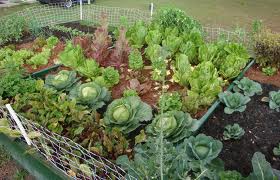This year with the drought in large areas of the US, water conservation is more important than ever. Here where we live we are making decisions on whether to water decorative plants or vegetable gardens. Surprisingly at least to me many people are choosing their lawns. Me I am choosing the vegetable garden. So this post will deal with vegetables and not ornamental plants.
With a vegetable garden, you need an adequate supply of water during the growing season. This is directly related to produce quality and yields. Vegetables can’t go dormant like many other plants.
Choose native plants if possible. Growing edible plants that are native to your area will normally save water. Native plants have evolved to live off the precipitation and weather patterns in your area. If you live in a dry area, they store water from spring rains so they can survive during dry summers. With a little research, you will find many edible plants that will do well in your area with little water.
Use of a drip system on a mulched garden can conserve water by 50%.
Now I know that most of us want to grow a good variety of crops some of which will require constant watering. One good method of water conservation is using mulch. Mulch slows evaporation of water from the ground, mulch can be anything that covers the ground and blocks sunlight. It can be inorganic things, like old carpeting, plastic sheeting or landscape fabric spread over the top of the ground. Organic materials would include compost, newspapers, straw, sawdust, wood chips or bark. Compost can be dug into the soil. In sandy soils, organic matter holds over ten times more water than the sand. In a vegetable garden, do not dig in woody materials such as bark or wood chips, as they may interfere with seedbed preparation and can result in soil nitrogen depletion.
The time of day you water can be critical. Watering your garden during the middle of a hot sunny day will result in a high rate of evaporation. The roots of many plants can maintain plenty of moisture even after several days without water. Watch your plants and learn how frequently they need watering.
Use plants that are drought resistant. Any good nursery should be able to give you some guidance to what will do well in the area in which you live. Some plants require more water than others because they breath out moisture For example a tomato plant breaths out about 30 gallons of water, over its lifespan; but a single corn stalk will breath out 55 gallons. Vegetables plants are 80 to 95 percent water, and some of that is breathed back into the air. Choosing your plants can help you conserve water.
Plants need more water at critical periods in their growth As a guideline, water is most critical during seed germination, the first few weeks of growth , immediately after transplanting, and during flowering and fruit production.
Here are some water conservation guidelines for specific vegetables.
Asparagus needs water most critically during spear production and fern growth. Less water is needed after ferns reach full size.
Cole crops (broccoli, cabbage, cauliflower, collards, Brussels sprouts, kale, and kohlrabi) need consistent moisture during their entire life span.
Beans have the highest water use of any common garden vegetable. During blossoming and fruit development, beans use one-quarter to over one-half inch of water per day.
Carrot and other root crops require consistent moisture. Cracking, knobby and hot flavored root crops are symptoms of water stress.
Corn water demand peaks during tasseling, silking, and ear development. Yield is directly related to quantities of water, nitrogen, and spacing.
Lettuce and other leaf vegetables need water most critically during leaf development. For quality produce, these crops require a constant supply of moisture.
Onion family crops require consistent moisture and frequent irrigation due to their small, inefficient root system.
Peas need water most critically during pod filling.
Potatoes tubers will be knobby if they become overly dry during tuber development.
Tomato family (tomatoes, peppers, and eggplant) needs water most critically during flowering and fruiting. The tomato family has a lower water requirement than many vegetables and plants are often over-watered in the typical home garden.
Vine crops: cucumbers, summer and winter squash, and assorted melons need water most critically during flowering and fruiting. Vine crops use less water than many vegetables and are often over-watered in the typical home garden.
Hopefully this will help you with water conservation and growing a nice garden this summer.
Howard



Water is life.We need to establish ways of conserving the little water we have.Water harvesting need to be embraced.The water sources also need to be protected.The water we harvest will be used during dry seasons. Thanks for creating awareness.